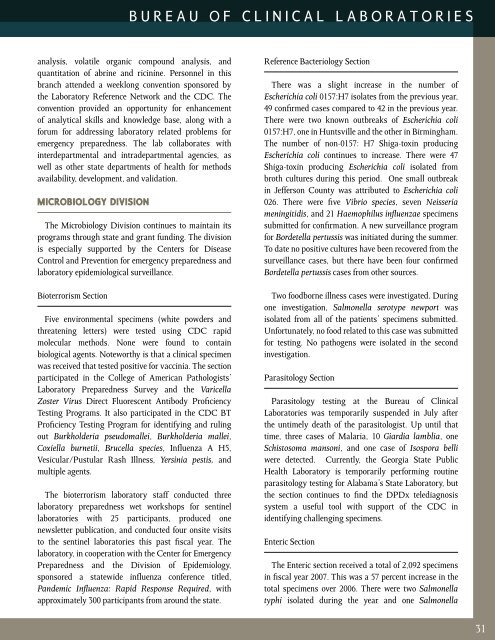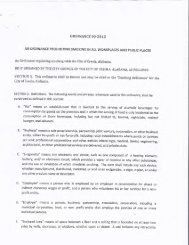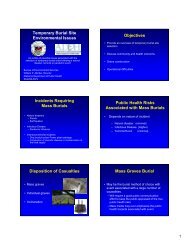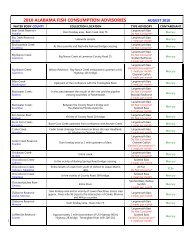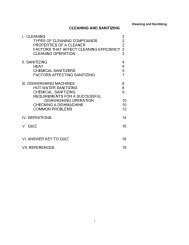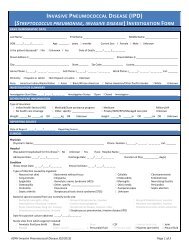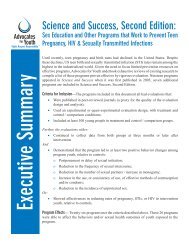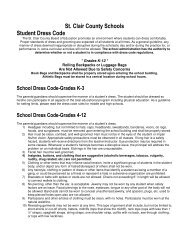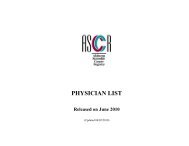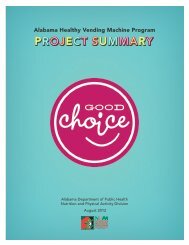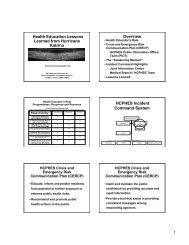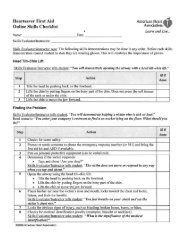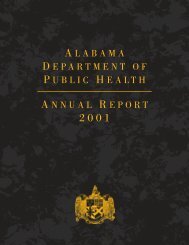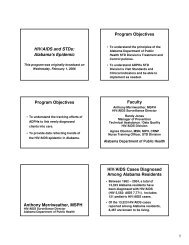2007 - Alabama Department of Public Health
2007 - Alabama Department of Public Health
2007 - Alabama Department of Public Health
Create successful ePaper yourself
Turn your PDF publications into a flip-book with our unique Google optimized e-Paper software.
ureau <strong>of</strong> clinical laboratories<br />
analysis, volatile organic compound analysis, and<br />
quantitation <strong>of</strong> abrine and ricinine. Personnel in this<br />
branch attended a weeklong convention sponsored by<br />
the Laboratory Reference Network and the CDC. The<br />
convention provided an opportunity for enhancement<br />
<strong>of</strong> analytical skills and knowledge base, along with a<br />
forum for addressing laboratory related problems for<br />
emergency preparedness. The lab collaborates with<br />
interdepartmental and intradepartmental agencies, as<br />
well as other state departments <strong>of</strong> health for methods<br />
availability, development, and validation.<br />
Microbiology Division<br />
The Microbiology Division continues to maintain its<br />
programs through state and grant funding. The division<br />
is especially supported by the Centers for Disease<br />
Control and Prevention for emergency preparedness and<br />
laboratory epidemiological surveillance.<br />
Bioterrorism Section<br />
Five environmental specimens (white powders and<br />
threatening letters) were tested using CDC rapid<br />
molecular methods. None were found to contain<br />
biological agents. Noteworthy is that a clinical specimen<br />
was received that tested positive for vaccinia. The section<br />
participated in the College <strong>of</strong> American Pathologists’<br />
Laboratory Preparedness Survey and the Varicella<br />
Zoster Virus Direct Fluorescent Antibody Pr<strong>of</strong>iciency<br />
Testing Programs. It also participated in the CDC BT<br />
Pr<strong>of</strong>iciency Testing Program for identifying and ruling<br />
out Burkholderia pseudomallei, Burkholderia mallei,<br />
Coxiella burnetii, Brucella species, Influenza A H5,<br />
Vesicular/Pustular Rash Illness, Yersinia pestis, and<br />
multiple agents.<br />
The bioterrorism laboratory staff conducted three<br />
laboratory preparedness wet workshops for sentinel<br />
laboratories with 25 participants, produced one<br />
newsletter publication, and conducted four onsite visits<br />
to the sentinel laboratories this past fiscal year. The<br />
laboratory, in cooperation with the Center for Emergency<br />
Preparedness and the Division <strong>of</strong> Epidemiology,<br />
sponsored a statewide influenza conference titled,<br />
Pandemic Influenza: Rapid Response Required, with<br />
approximately 300 participants from around the state.<br />
Reference Bacteriology Section<br />
There was a slight increase in the number <strong>of</strong><br />
Escherichia coli 0157:H7 isolates from the previous year,<br />
49 confirmed cases compared to 42 in the previous year.<br />
There were two known outbreaks <strong>of</strong> Escherichia coli<br />
0157:H7, one in Huntsville and the other in Birmingham.<br />
The number <strong>of</strong> non-0157: H7 Shiga-toxin producing<br />
Escherichia coli continues to increase. There were 47<br />
Shiga-toxin producing Escherichia coli isolated from<br />
broth cultures during this period. One small outbreak<br />
in Jefferson County was attributed to Escherichia coli<br />
026. There were five Vibrio species, seven Neisseria<br />
meningitidis, and 21 Haemophilus influenzae specimens<br />
submitted for confirmation. A new surveillance program<br />
for Bordetella pertussis was initiated during the summer.<br />
To date no positive cultures have been recovered from the<br />
surveillance cases, but there have been four confirmed<br />
Bordetella pertussis cases from other sources.<br />
Two foodborne illness cases were investigated. During<br />
one investigation, Salmonella serotype newport was<br />
isolated from all <strong>of</strong> the patients’ specimens submitted.<br />
Unfortunately, no food related to this case was submitted<br />
for testing. No pathogens were isolated in the second<br />
investigation.<br />
Parasitology Section<br />
Parasitology testing at the Bureau <strong>of</strong> Clinical<br />
Laboratories was temporarily suspended in July after<br />
the untimely death <strong>of</strong> the parasitologist. Up until that<br />
time, three cases <strong>of</strong> Malaria, 10 Giardia lamblia, one<br />
Schistosoma mansoni, and one case <strong>of</strong> Isospora belli<br />
were detected. Currently, the Georgia State <strong>Public</strong><br />
<strong>Health</strong> Laboratory is temporarily performing routine<br />
parasitology testing for <strong>Alabama</strong>’s State Laboratory, but<br />
the section continues to find the DPDx telediagnosis<br />
system a useful tool with support <strong>of</strong> the CDC in<br />
identifying challenging specimens.<br />
Enteric Section<br />
The Enteric section received a total <strong>of</strong> 2,092 specimens<br />
in fiscal year <strong>2007</strong>. This was a 57 percent increase in the<br />
total specimens over 2006. There were two Salmonella<br />
typhi isolated during the year and one Salmonella<br />
31


